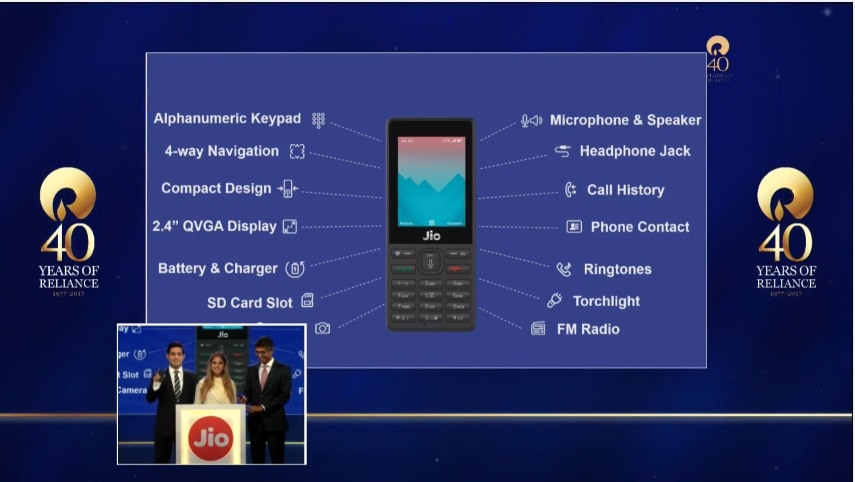Reliance Jio announced the launch of the Jio Phone at the annual Reliance Industries AGM on Friday. The effective price of the phone is zero - you need to pay a Rs. 1,500 deposit up front, which is refundable after three years. Jio Phone users can enjoy Reliance Jio services like free voice calling and SMS, as well as access to Jio apps like JioTV and JioMovies at Rs. 153 per month, Reliance Industries Chairman Mukesh Ambani said. This Jio plan also gets you 'unlimited' Internet data, with a daily high-speed data cap of 500MB.
So is the Jio Phone going to be the phone that gets the next set of Indians on the Internet? What are its limitations? Does the Jio Phone run WhatsApp? Read on for the answers to these, and other questions.
Jio Phone launch date and booking
The Jio Phone will be made available starting August 15 in a beta programme, and it will be up for pre-booking from August 24 onwards. Pre-orders can be made using the MyJio app or Jio offline stores. Customers who pre-book the phone will be eligible to purchase it from September onwards, on a first come first serve basis. Mukesh Ambani said Jio is targeting to have 5 million Jio Phones available every week.
ALSO SEEWant to Buy Jio Phone? Here's the Booking Process
Jio Phone cable TV and plans
There are two prepaid plans that you can sign up to with the Jio Phone. Both have a one month (28 days) validity, and include 'unlimited' data, unlimited calling, and SMS. The plans are for Rs. 153 and Rs. 309 respectively, and on the surface look very similar, but there's one difference. With the Rs. 309 plan, users will be able to use the Jio Phone-TV cable to mirror their phone screen onto any TV, so that Jio's streaming services can be enjoyed by the whole family. The Rs. 153 plan come with 500MB daily FUP for the high-speed data.
At the same time, Ambani also noted that for users who don't want to commit to a monthly plan, Reliance Jio also has a couple of sachet plans that give shorter term access to data. For two days, Jio Phone users can get the Rs. 24 pack, or they can opt to spend Rs. 54 for a week of usage. Note that these plans are exclusive to Jio Phone users and cannot be subscribed by other Jio users.
Jio Phone features and price
Introduced as "India ka smartphone", the Jio Phone will be effectively free. Of course, it's not quite as simple as that - you will have to make an upfront payment of Rs. 1,500 in order to get your hands on the Jio Phone. However, this sum is fully refundable, but you can claim the refund only after three years of purchasing the mobile.
Introduced as "India ka smartphone", the Jio Phone will be effectively free. Of course, it's not quite as simple as that - you will have to make an upfront payment of Rs. 1,500 in order to get your hands on the Jio Phone. However, this sum is fully refundable, but you can claim the refund only after three years of purchasing the mobile.
ALSO SEEWhat is the Jio Phone TV-Cable?
In his AGM speech, Reliance Chairman Mukesh Ambani pointed out the majority of phone users in India do not have smartphones, pegging the figure at 50 crore (out of 76 crore mobile phone users). Because of the high smartphone prices, they are unable to access the 4G-only Jio network, meaning not only are they unable to get access to high-speed Internet and free voice calls, but also that they are out of Jio's reach as a monetisation opportunity. The Jio Phone is meant to address this audience, and thus is an affordable, 4G VoLTE-capable feature phone with 'smart' apps.
Yes, the Jio Phone's got all of the Jio apps - that means Jio Music, Jio Cinema and so on, and access to these is bundled with the prepaid plans for the phone, so even on a feature phone you'll be able to enjoy streaming services. It supports other apps as well, including Facebook, though WhatsApp is not supported at the moment. The phone also supports 22 Indian languages, and voice commands. You can send messages, place calls, search the Web, and so on, using voice commands.
Another interesting feature of the Jio Phone is NFC support - with this, users will be able to make payments from a linked bank account via UPI, or through POS machines in place of a debit card. This will be enabled later via a software update, although the hardware is already present. The mobile also comes with an integrated panic button.
ALSO SEEJio Phone Launch in Pictures
 Jio Phone features revealed at the Reliance AGM
Jio Phone features revealed at the Reliance AGMThe Jio Phone will also be able to mirror content from apps such as JioTV and JioCinema on TVs (including old CRT TVs) using a cable that the company has developed. Users will need to subscribe to the Rs. 309 Jio pack to avail this feature.
While company went in detail regarding the features, there was not as much focus on Jio Phone specifications. As a feature phone, the device has an alphanumeric keypad, and a small 2.4-inch colour screen. Apart from the presence of a rear camera, FM radio, Bluetooth, NFC, and of course 4G VoLTE, not much is confirmed at the moment.






